Psychology Crime: An Analysis of Intimate Partner Violence Causes
VerifiedAdded on 2021/12/17
|13
|5034
|103
Essay
AI Summary
This essay delves into the psychology of crime, specifically focusing on intimate partner violence (IPV). It explores the multifaceted nature of IPV, defining it as physical, sexual, or psychological harm inflicted by an intimate partner. The essay examines the prevalence of IPV, highlighting the biological and social factors that contribute to its occurrence. The biological perspective encompasses genetic, hormonal, and neurological influences, while the social perspective considers factors like peer pressure and cultural norms. The essay provides a detailed comparison of the biological and social approaches, discussing their respective strengths and weaknesses. It concludes by emphasizing the importance of preventive measures and interventions to combat IPV, including legal reforms, support for victims, and community-based programs.
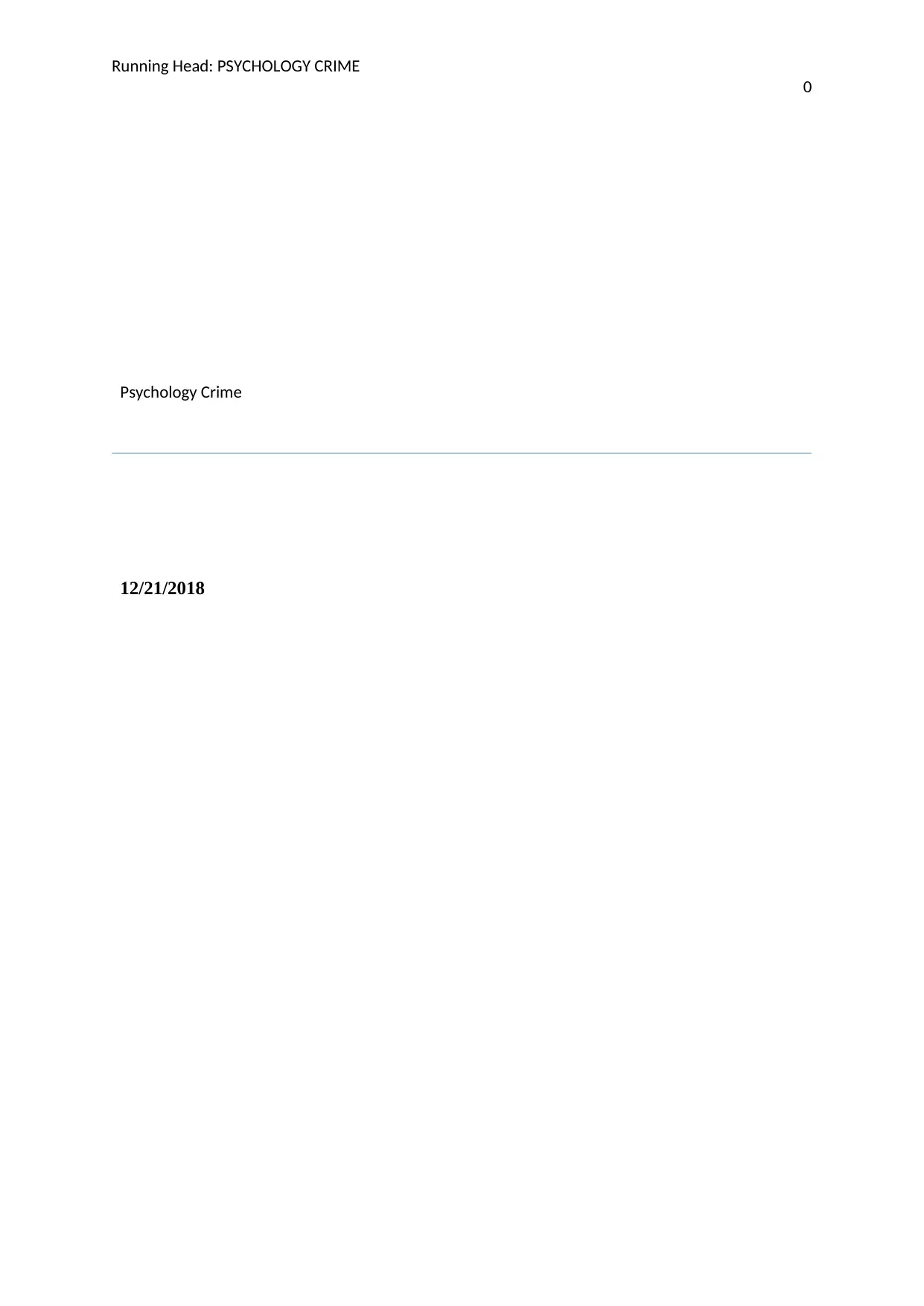
Running Head: PSYCHOLOGY CRIME
0
Psychology Crime
12/21/2018
0
Psychology Crime
12/21/2018
Paraphrase This Document
Need a fresh take? Get an instant paraphrase of this document with our AI Paraphraser
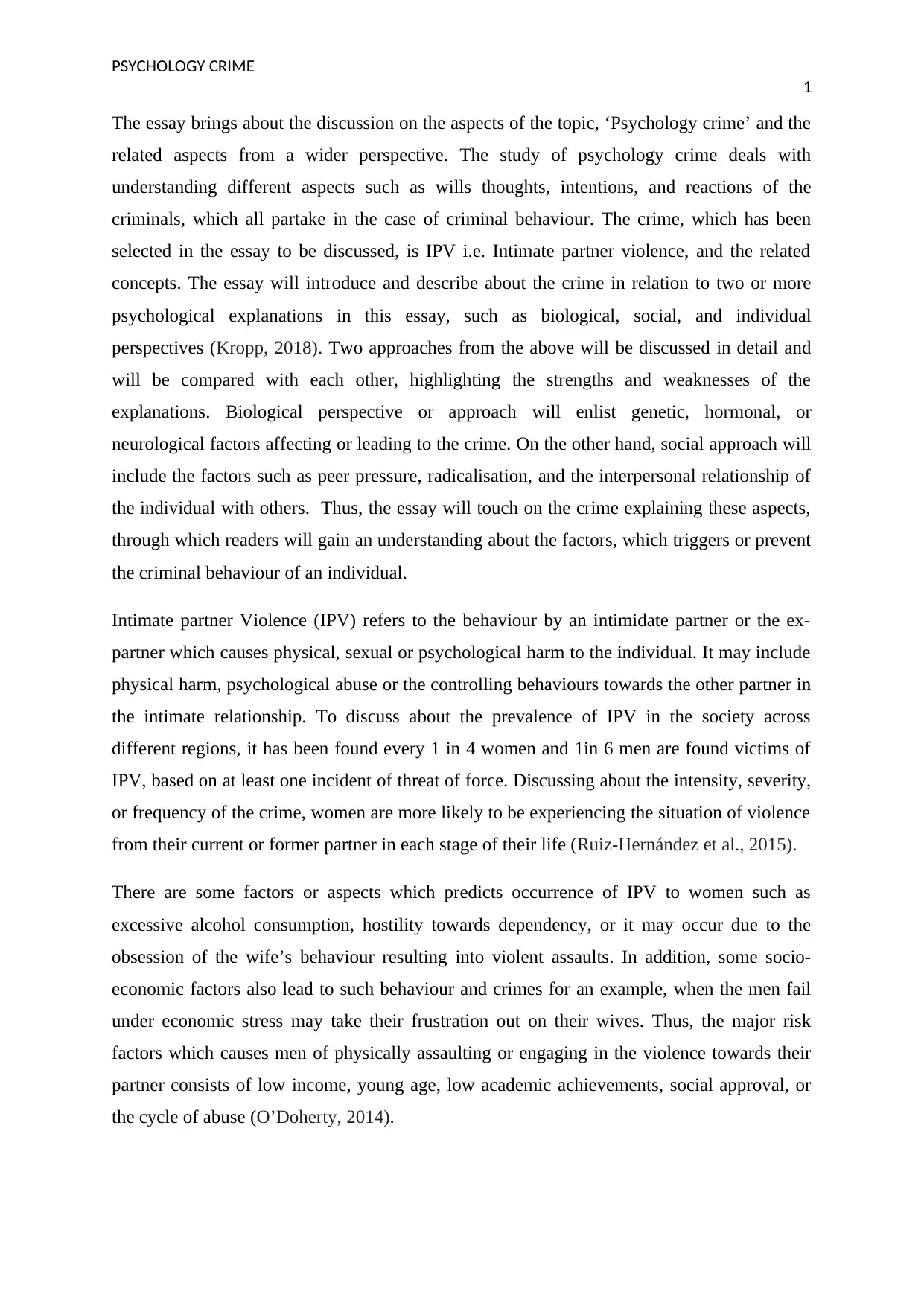
PSYCHOLOGY CRIME
1
The essay brings about the discussion on the aspects of the topic, ‘Psychology crime’ and the
related aspects from a wider perspective. The study of psychology crime deals with
understanding different aspects such as wills thoughts, intentions, and reactions of the
criminals, which all partake in the case of criminal behaviour. The crime, which has been
selected in the essay to be discussed, is IPV i.e. Intimate partner violence, and the related
concepts. The essay will introduce and describe about the crime in relation to two or more
psychological explanations in this essay, such as biological, social, and individual
perspectives (Kropp, 2018). Two approaches from the above will be discussed in detail and
will be compared with each other, highlighting the strengths and weaknesses of the
explanations. Biological perspective or approach will enlist genetic, hormonal, or
neurological factors affecting or leading to the crime. On the other hand, social approach will
include the factors such as peer pressure, radicalisation, and the interpersonal relationship of
the individual with others. Thus, the essay will touch on the crime explaining these aspects,
through which readers will gain an understanding about the factors, which triggers or prevent
the criminal behaviour of an individual.
Intimate partner Violence (IPV) refers to the behaviour by an intimidate partner or the ex-
partner which causes physical, sexual or psychological harm to the individual. It may include
physical harm, psychological abuse or the controlling behaviours towards the other partner in
the intimate relationship. To discuss about the prevalence of IPV in the society across
different regions, it has been found every 1 in 4 women and 1in 6 men are found victims of
IPV, based on at least one incident of threat of force. Discussing about the intensity, severity,
or frequency of the crime, women are more likely to be experiencing the situation of violence
from their current or former partner in each stage of their life (Ruiz-Hernández et al., 2015).
There are some factors or aspects which predicts occurrence of IPV to women such as
excessive alcohol consumption, hostility towards dependency, or it may occur due to the
obsession of the wife’s behaviour resulting into violent assaults. In addition, some socio-
economic factors also lead to such behaviour and crimes for an example, when the men fail
under economic stress may take their frustration out on their wives. Thus, the major risk
factors which causes men of physically assaulting or engaging in the violence towards their
partner consists of low income, young age, low academic achievements, social approval, or
the cycle of abuse (O’Doherty, 2014).
1
The essay brings about the discussion on the aspects of the topic, ‘Psychology crime’ and the
related aspects from a wider perspective. The study of psychology crime deals with
understanding different aspects such as wills thoughts, intentions, and reactions of the
criminals, which all partake in the case of criminal behaviour. The crime, which has been
selected in the essay to be discussed, is IPV i.e. Intimate partner violence, and the related
concepts. The essay will introduce and describe about the crime in relation to two or more
psychological explanations in this essay, such as biological, social, and individual
perspectives (Kropp, 2018). Two approaches from the above will be discussed in detail and
will be compared with each other, highlighting the strengths and weaknesses of the
explanations. Biological perspective or approach will enlist genetic, hormonal, or
neurological factors affecting or leading to the crime. On the other hand, social approach will
include the factors such as peer pressure, radicalisation, and the interpersonal relationship of
the individual with others. Thus, the essay will touch on the crime explaining these aspects,
through which readers will gain an understanding about the factors, which triggers or prevent
the criminal behaviour of an individual.
Intimate partner Violence (IPV) refers to the behaviour by an intimidate partner or the ex-
partner which causes physical, sexual or psychological harm to the individual. It may include
physical harm, psychological abuse or the controlling behaviours towards the other partner in
the intimate relationship. To discuss about the prevalence of IPV in the society across
different regions, it has been found every 1 in 4 women and 1in 6 men are found victims of
IPV, based on at least one incident of threat of force. Discussing about the intensity, severity,
or frequency of the crime, women are more likely to be experiencing the situation of violence
from their current or former partner in each stage of their life (Ruiz-Hernández et al., 2015).
There are some factors or aspects which predicts occurrence of IPV to women such as
excessive alcohol consumption, hostility towards dependency, or it may occur due to the
obsession of the wife’s behaviour resulting into violent assaults. In addition, some socio-
economic factors also lead to such behaviour and crimes for an example, when the men fail
under economic stress may take their frustration out on their wives. Thus, the major risk
factors which causes men of physically assaulting or engaging in the violence towards their
partner consists of low income, young age, low academic achievements, social approval, or
the cycle of abuse (O’Doherty, 2014).
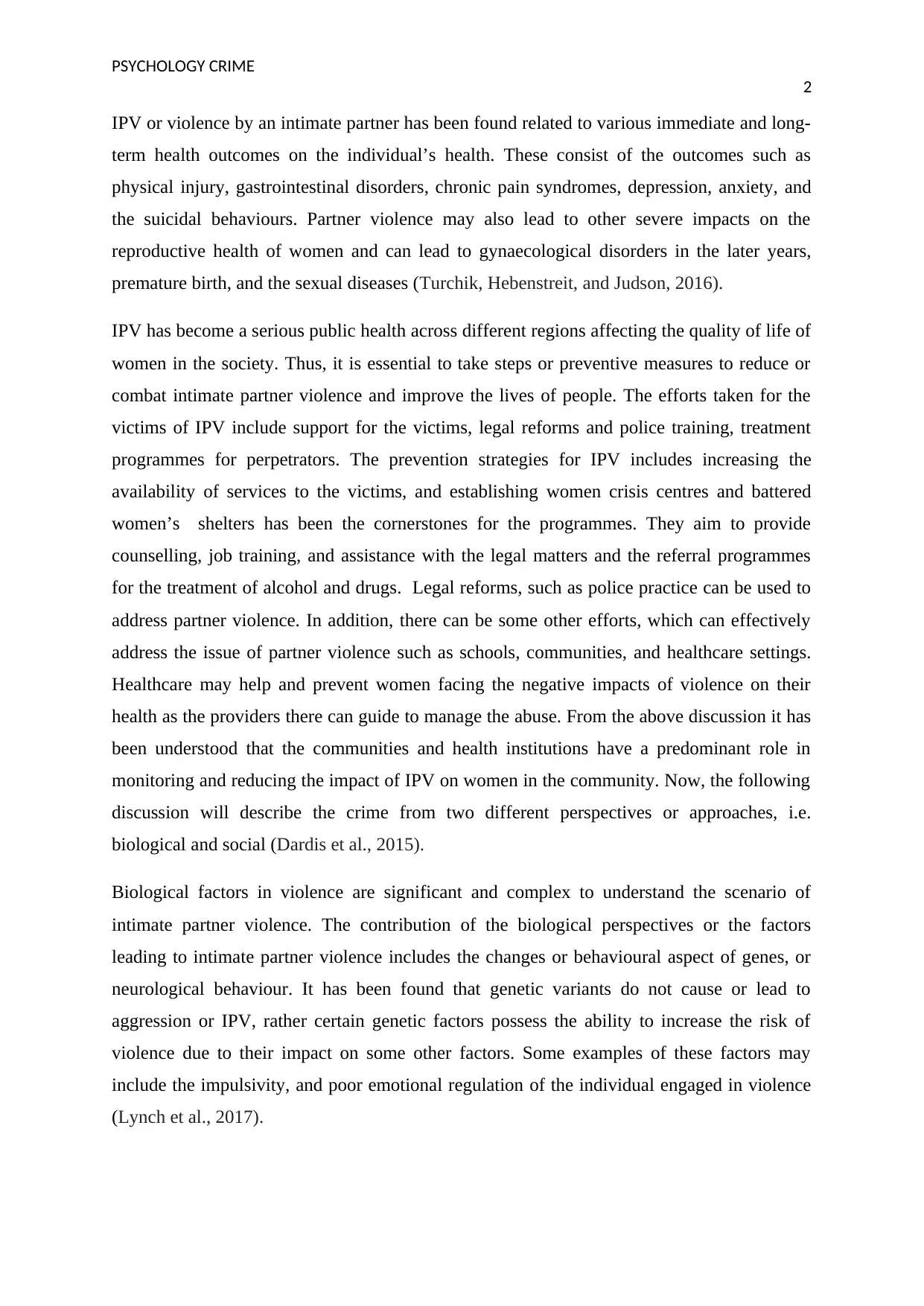
PSYCHOLOGY CRIME
2
IPV or violence by an intimate partner has been found related to various immediate and long-
term health outcomes on the individual’s health. These consist of the outcomes such as
physical injury, gastrointestinal disorders, chronic pain syndromes, depression, anxiety, and
the suicidal behaviours. Partner violence may also lead to other severe impacts on the
reproductive health of women and can lead to gynaecological disorders in the later years,
premature birth, and the sexual diseases (Turchik, Hebenstreit, and Judson, 2016).
IPV has become a serious public health across different regions affecting the quality of life of
women in the society. Thus, it is essential to take steps or preventive measures to reduce or
combat intimate partner violence and improve the lives of people. The efforts taken for the
victims of IPV include support for the victims, legal reforms and police training, treatment
programmes for perpetrators. The prevention strategies for IPV includes increasing the
availability of services to the victims, and establishing women crisis centres and battered
women’s shelters has been the cornerstones for the programmes. They aim to provide
counselling, job training, and assistance with the legal matters and the referral programmes
for the treatment of alcohol and drugs. Legal reforms, such as police practice can be used to
address partner violence. In addition, there can be some other efforts, which can effectively
address the issue of partner violence such as schools, communities, and healthcare settings.
Healthcare may help and prevent women facing the negative impacts of violence on their
health as the providers there can guide to manage the abuse. From the above discussion it has
been understood that the communities and health institutions have a predominant role in
monitoring and reducing the impact of IPV on women in the community. Now, the following
discussion will describe the crime from two different perspectives or approaches, i.e.
biological and social (Dardis et al., 2015).
Biological factors in violence are significant and complex to understand the scenario of
intimate partner violence. The contribution of the biological perspectives or the factors
leading to intimate partner violence includes the changes or behavioural aspect of genes, or
neurological behaviour. It has been found that genetic variants do not cause or lead to
aggression or IPV, rather certain genetic factors possess the ability to increase the risk of
violence due to their impact on some other factors. Some examples of these factors may
include the impulsivity, and poor emotional regulation of the individual engaged in violence
(Lynch et al., 2017).
2
IPV or violence by an intimate partner has been found related to various immediate and long-
term health outcomes on the individual’s health. These consist of the outcomes such as
physical injury, gastrointestinal disorders, chronic pain syndromes, depression, anxiety, and
the suicidal behaviours. Partner violence may also lead to other severe impacts on the
reproductive health of women and can lead to gynaecological disorders in the later years,
premature birth, and the sexual diseases (Turchik, Hebenstreit, and Judson, 2016).
IPV has become a serious public health across different regions affecting the quality of life of
women in the society. Thus, it is essential to take steps or preventive measures to reduce or
combat intimate partner violence and improve the lives of people. The efforts taken for the
victims of IPV include support for the victims, legal reforms and police training, treatment
programmes for perpetrators. The prevention strategies for IPV includes increasing the
availability of services to the victims, and establishing women crisis centres and battered
women’s shelters has been the cornerstones for the programmes. They aim to provide
counselling, job training, and assistance with the legal matters and the referral programmes
for the treatment of alcohol and drugs. Legal reforms, such as police practice can be used to
address partner violence. In addition, there can be some other efforts, which can effectively
address the issue of partner violence such as schools, communities, and healthcare settings.
Healthcare may help and prevent women facing the negative impacts of violence on their
health as the providers there can guide to manage the abuse. From the above discussion it has
been understood that the communities and health institutions have a predominant role in
monitoring and reducing the impact of IPV on women in the community. Now, the following
discussion will describe the crime from two different perspectives or approaches, i.e.
biological and social (Dardis et al., 2015).
Biological factors in violence are significant and complex to understand the scenario of
intimate partner violence. The contribution of the biological perspectives or the factors
leading to intimate partner violence includes the changes or behavioural aspect of genes, or
neurological behaviour. It has been found that genetic variants do not cause or lead to
aggression or IPV, rather certain genetic factors possess the ability to increase the risk of
violence due to their impact on some other factors. Some examples of these factors may
include the impulsivity, and poor emotional regulation of the individual engaged in violence
(Lynch et al., 2017).
⊘ This is a preview!⊘
Do you want full access?
Subscribe today to unlock all pages.

Trusted by 1+ million students worldwide
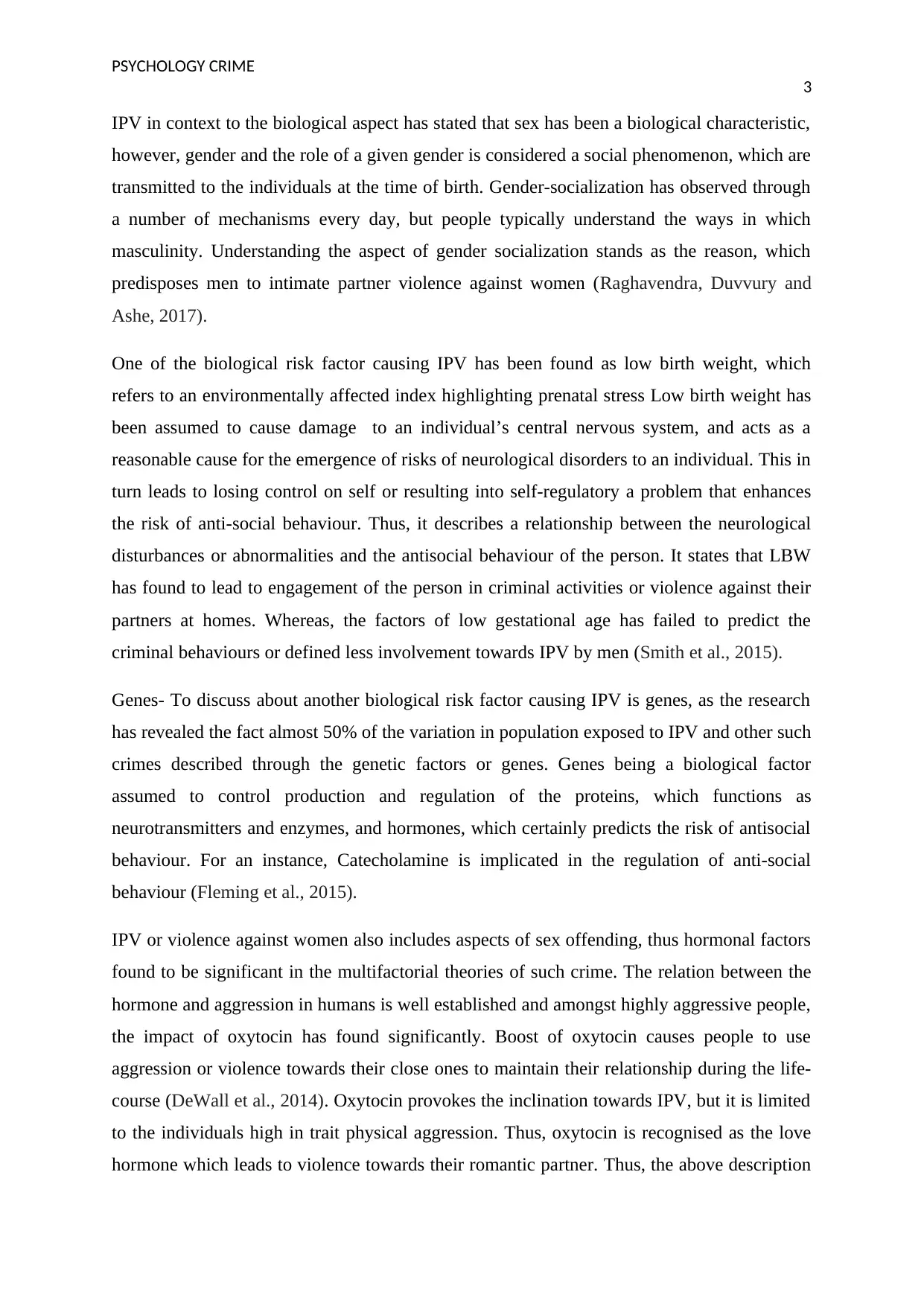
PSYCHOLOGY CRIME
3
IPV in context to the biological aspect has stated that sex has been a biological characteristic,
however, gender and the role of a given gender is considered a social phenomenon, which are
transmitted to the individuals at the time of birth. Gender-socialization has observed through
a number of mechanisms every day, but people typically understand the ways in which
masculinity. Understanding the aspect of gender socialization stands as the reason, which
predisposes men to intimate partner violence against women (Raghavendra, Duvvury and
Ashe, 2017).
One of the biological risk factor causing IPV has been found as low birth weight, which
refers to an environmentally affected index highlighting prenatal stress Low birth weight has
been assumed to cause damage to an individual’s central nervous system, and acts as a
reasonable cause for the emergence of risks of neurological disorders to an individual. This in
turn leads to losing control on self or resulting into self-regulatory a problem that enhances
the risk of anti-social behaviour. Thus, it describes a relationship between the neurological
disturbances or abnormalities and the antisocial behaviour of the person. It states that LBW
has found to lead to engagement of the person in criminal activities or violence against their
partners at homes. Whereas, the factors of low gestational age has failed to predict the
criminal behaviours or defined less involvement towards IPV by men (Smith et al., 2015).
Genes- To discuss about another biological risk factor causing IPV is genes, as the research
has revealed the fact almost 50% of the variation in population exposed to IPV and other such
crimes described through the genetic factors or genes. Genes being a biological factor
assumed to control production and regulation of the proteins, which functions as
neurotransmitters and enzymes, and hormones, which certainly predicts the risk of antisocial
behaviour. For an instance, Catecholamine is implicated in the regulation of anti-social
behaviour (Fleming et al., 2015).
IPV or violence against women also includes aspects of sex offending, thus hormonal factors
found to be significant in the multifactorial theories of such crime. The relation between the
hormone and aggression in humans is well established and amongst highly aggressive people,
the impact of oxytocin has found significantly. Boost of oxytocin causes people to use
aggression or violence towards their close ones to maintain their relationship during the life-
course (DeWall et al., 2014). Oxytocin provokes the inclination towards IPV, but it is limited
to the individuals high in trait physical aggression. Thus, oxytocin is recognised as the love
hormone which leads to violence towards their romantic partner. Thus, the above description
3
IPV in context to the biological aspect has stated that sex has been a biological characteristic,
however, gender and the role of a given gender is considered a social phenomenon, which are
transmitted to the individuals at the time of birth. Gender-socialization has observed through
a number of mechanisms every day, but people typically understand the ways in which
masculinity. Understanding the aspect of gender socialization stands as the reason, which
predisposes men to intimate partner violence against women (Raghavendra, Duvvury and
Ashe, 2017).
One of the biological risk factor causing IPV has been found as low birth weight, which
refers to an environmentally affected index highlighting prenatal stress Low birth weight has
been assumed to cause damage to an individual’s central nervous system, and acts as a
reasonable cause for the emergence of risks of neurological disorders to an individual. This in
turn leads to losing control on self or resulting into self-regulatory a problem that enhances
the risk of anti-social behaviour. Thus, it describes a relationship between the neurological
disturbances or abnormalities and the antisocial behaviour of the person. It states that LBW
has found to lead to engagement of the person in criminal activities or violence against their
partners at homes. Whereas, the factors of low gestational age has failed to predict the
criminal behaviours or defined less involvement towards IPV by men (Smith et al., 2015).
Genes- To discuss about another biological risk factor causing IPV is genes, as the research
has revealed the fact almost 50% of the variation in population exposed to IPV and other such
crimes described through the genetic factors or genes. Genes being a biological factor
assumed to control production and regulation of the proteins, which functions as
neurotransmitters and enzymes, and hormones, which certainly predicts the risk of antisocial
behaviour. For an instance, Catecholamine is implicated in the regulation of anti-social
behaviour (Fleming et al., 2015).
IPV or violence against women also includes aspects of sex offending, thus hormonal factors
found to be significant in the multifactorial theories of such crime. The relation between the
hormone and aggression in humans is well established and amongst highly aggressive people,
the impact of oxytocin has found significantly. Boost of oxytocin causes people to use
aggression or violence towards their close ones to maintain their relationship during the life-
course (DeWall et al., 2014). Oxytocin provokes the inclination towards IPV, but it is limited
to the individuals high in trait physical aggression. Thus, oxytocin is recognised as the love
hormone which leads to violence towards their romantic partner. Thus, the above description
Paraphrase This Document
Need a fresh take? Get an instant paraphrase of this document with our AI Paraphraser
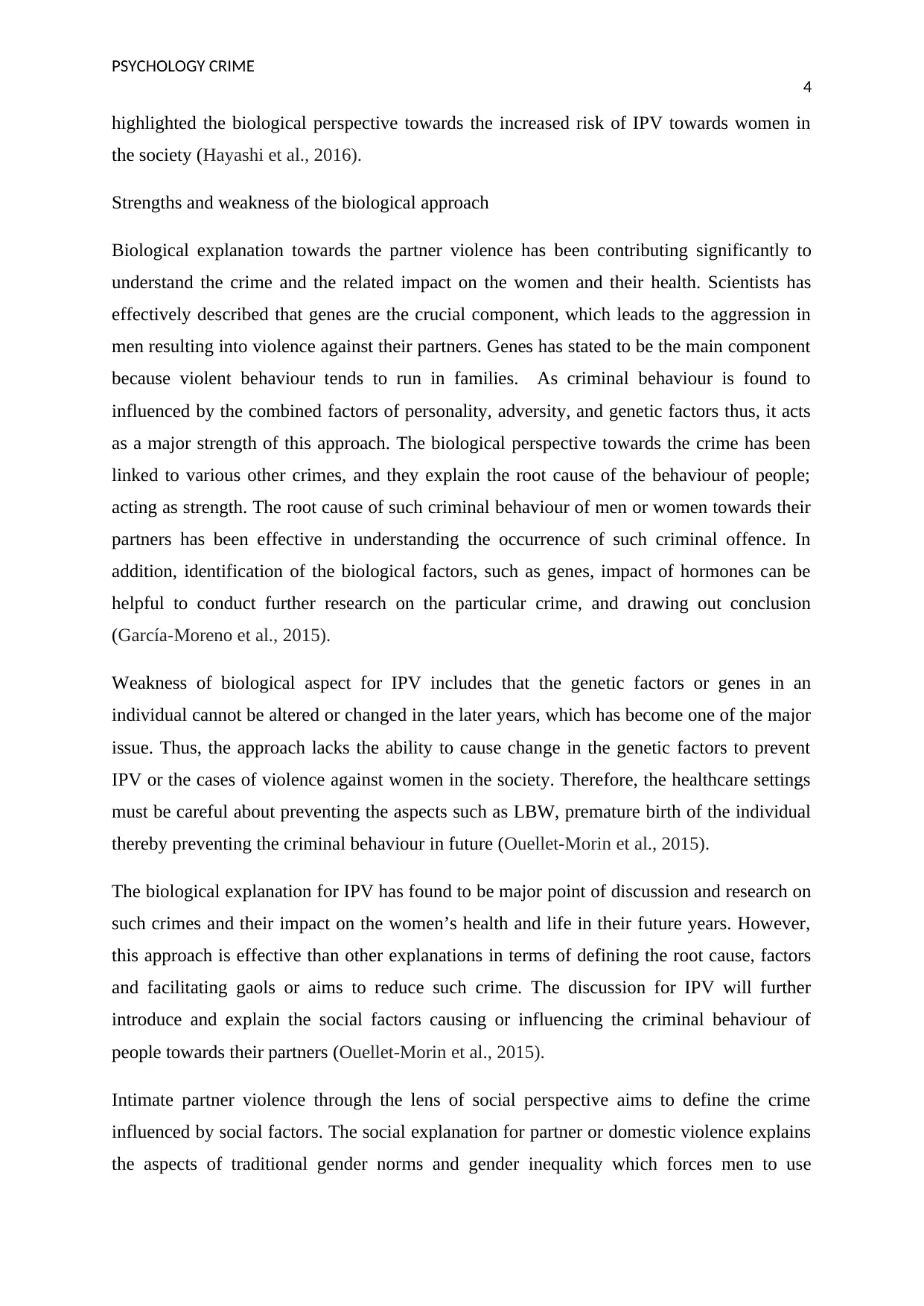
PSYCHOLOGY CRIME
4
highlighted the biological perspective towards the increased risk of IPV towards women in
the society (Hayashi et al., 2016).
Strengths and weakness of the biological approach
Biological explanation towards the partner violence has been contributing significantly to
understand the crime and the related impact on the women and their health. Scientists has
effectively described that genes are the crucial component, which leads to the aggression in
men resulting into violence against their partners. Genes has stated to be the main component
because violent behaviour tends to run in families. As criminal behaviour is found to
influenced by the combined factors of personality, adversity, and genetic factors thus, it acts
as a major strength of this approach. The biological perspective towards the crime has been
linked to various other crimes, and they explain the root cause of the behaviour of people;
acting as strength. The root cause of such criminal behaviour of men or women towards their
partners has been effective in understanding the occurrence of such criminal offence. In
addition, identification of the biological factors, such as genes, impact of hormones can be
helpful to conduct further research on the particular crime, and drawing out conclusion
(García-Moreno et al., 2015).
Weakness of biological aspect for IPV includes that the genetic factors or genes in an
individual cannot be altered or changed in the later years, which has become one of the major
issue. Thus, the approach lacks the ability to cause change in the genetic factors to prevent
IPV or the cases of violence against women in the society. Therefore, the healthcare settings
must be careful about preventing the aspects such as LBW, premature birth of the individual
thereby preventing the criminal behaviour in future (Ouellet‐Morin et al., 2015).
The biological explanation for IPV has found to be major point of discussion and research on
such crimes and their impact on the women’s health and life in their future years. However,
this approach is effective than other explanations in terms of defining the root cause, factors
and facilitating gaols or aims to reduce such crime. The discussion for IPV will further
introduce and explain the social factors causing or influencing the criminal behaviour of
people towards their partners (Ouellet‐Morin et al., 2015).
Intimate partner violence through the lens of social perspective aims to define the crime
influenced by social factors. The social explanation for partner or domestic violence explains
the aspects of traditional gender norms and gender inequality which forces men to use
4
highlighted the biological perspective towards the increased risk of IPV towards women in
the society (Hayashi et al., 2016).
Strengths and weakness of the biological approach
Biological explanation towards the partner violence has been contributing significantly to
understand the crime and the related impact on the women and their health. Scientists has
effectively described that genes are the crucial component, which leads to the aggression in
men resulting into violence against their partners. Genes has stated to be the main component
because violent behaviour tends to run in families. As criminal behaviour is found to
influenced by the combined factors of personality, adversity, and genetic factors thus, it acts
as a major strength of this approach. The biological perspective towards the crime has been
linked to various other crimes, and they explain the root cause of the behaviour of people;
acting as strength. The root cause of such criminal behaviour of men or women towards their
partners has been effective in understanding the occurrence of such criminal offence. In
addition, identification of the biological factors, such as genes, impact of hormones can be
helpful to conduct further research on the particular crime, and drawing out conclusion
(García-Moreno et al., 2015).
Weakness of biological aspect for IPV includes that the genetic factors or genes in an
individual cannot be altered or changed in the later years, which has become one of the major
issue. Thus, the approach lacks the ability to cause change in the genetic factors to prevent
IPV or the cases of violence against women in the society. Therefore, the healthcare settings
must be careful about preventing the aspects such as LBW, premature birth of the individual
thereby preventing the criminal behaviour in future (Ouellet‐Morin et al., 2015).
The biological explanation for IPV has found to be major point of discussion and research on
such crimes and their impact on the women’s health and life in their future years. However,
this approach is effective than other explanations in terms of defining the root cause, factors
and facilitating gaols or aims to reduce such crime. The discussion for IPV will further
introduce and explain the social factors causing or influencing the criminal behaviour of
people towards their partners (Ouellet‐Morin et al., 2015).
Intimate partner violence through the lens of social perspective aims to define the crime
influenced by social factors. The social explanation for partner or domestic violence explains
the aspects of traditional gender norms and gender inequality which forces men to use
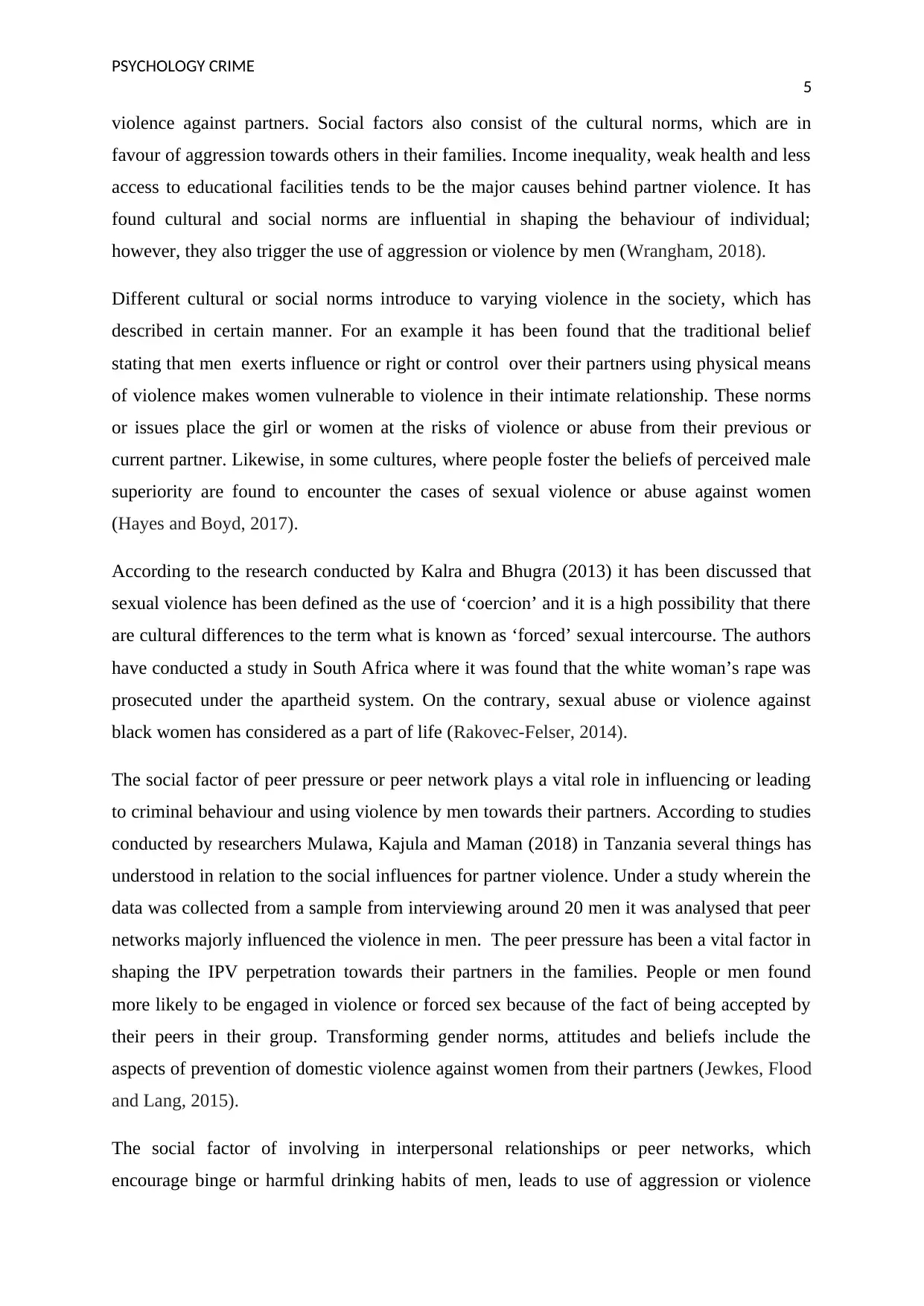
PSYCHOLOGY CRIME
5
violence against partners. Social factors also consist of the cultural norms, which are in
favour of aggression towards others in their families. Income inequality, weak health and less
access to educational facilities tends to be the major causes behind partner violence. It has
found cultural and social norms are influential in shaping the behaviour of individual;
however, they also trigger the use of aggression or violence by men (Wrangham, 2018).
Different cultural or social norms introduce to varying violence in the society, which has
described in certain manner. For an example it has been found that the traditional belief
stating that men exerts influence or right or control over their partners using physical means
of violence makes women vulnerable to violence in their intimate relationship. These norms
or issues place the girl or women at the risks of violence or abuse from their previous or
current partner. Likewise, in some cultures, where people foster the beliefs of perceived male
superiority are found to encounter the cases of sexual violence or abuse against women
(Hayes and Boyd, 2017).
According to the research conducted by Kalra and Bhugra (2013) it has been discussed that
sexual violence has been defined as the use of ‘coercion’ and it is a high possibility that there
are cultural differences to the term what is known as ‘forced’ sexual intercourse. The authors
have conducted a study in South Africa where it was found that the white woman’s rape was
prosecuted under the apartheid system. On the contrary, sexual abuse or violence against
black women has considered as a part of life (Rakovec-Felser, 2014).
The social factor of peer pressure or peer network plays a vital role in influencing or leading
to criminal behaviour and using violence by men towards their partners. According to studies
conducted by researchers Mulawa, Kajula and Maman (2018) in Tanzania several things has
understood in relation to the social influences for partner violence. Under a study wherein the
data was collected from a sample from interviewing around 20 men it was analysed that peer
networks majorly influenced the violence in men. The peer pressure has been a vital factor in
shaping the IPV perpetration towards their partners in the families. People or men found
more likely to be engaged in violence or forced sex because of the fact of being accepted by
their peers in their group. Transforming gender norms, attitudes and beliefs include the
aspects of prevention of domestic violence against women from their partners (Jewkes, Flood
and Lang, 2015).
The social factor of involving in interpersonal relationships or peer networks, which
encourage binge or harmful drinking habits of men, leads to use of aggression or violence
5
violence against partners. Social factors also consist of the cultural norms, which are in
favour of aggression towards others in their families. Income inequality, weak health and less
access to educational facilities tends to be the major causes behind partner violence. It has
found cultural and social norms are influential in shaping the behaviour of individual;
however, they also trigger the use of aggression or violence by men (Wrangham, 2018).
Different cultural or social norms introduce to varying violence in the society, which has
described in certain manner. For an example it has been found that the traditional belief
stating that men exerts influence or right or control over their partners using physical means
of violence makes women vulnerable to violence in their intimate relationship. These norms
or issues place the girl or women at the risks of violence or abuse from their previous or
current partner. Likewise, in some cultures, where people foster the beliefs of perceived male
superiority are found to encounter the cases of sexual violence or abuse against women
(Hayes and Boyd, 2017).
According to the research conducted by Kalra and Bhugra (2013) it has been discussed that
sexual violence has been defined as the use of ‘coercion’ and it is a high possibility that there
are cultural differences to the term what is known as ‘forced’ sexual intercourse. The authors
have conducted a study in South Africa where it was found that the white woman’s rape was
prosecuted under the apartheid system. On the contrary, sexual abuse or violence against
black women has considered as a part of life (Rakovec-Felser, 2014).
The social factor of peer pressure or peer network plays a vital role in influencing or leading
to criminal behaviour and using violence by men towards their partners. According to studies
conducted by researchers Mulawa, Kajula and Maman (2018) in Tanzania several things has
understood in relation to the social influences for partner violence. Under a study wherein the
data was collected from a sample from interviewing around 20 men it was analysed that peer
networks majorly influenced the violence in men. The peer pressure has been a vital factor in
shaping the IPV perpetration towards their partners in the families. People or men found
more likely to be engaged in violence or forced sex because of the fact of being accepted by
their peers in their group. Transforming gender norms, attitudes and beliefs include the
aspects of prevention of domestic violence against women from their partners (Jewkes, Flood
and Lang, 2015).
The social factor of involving in interpersonal relationships or peer networks, which
encourage binge or harmful drinking habits of men, leads to use of aggression or violence
⊘ This is a preview!⊘
Do you want full access?
Subscribe today to unlock all pages.

Trusted by 1+ million students worldwide
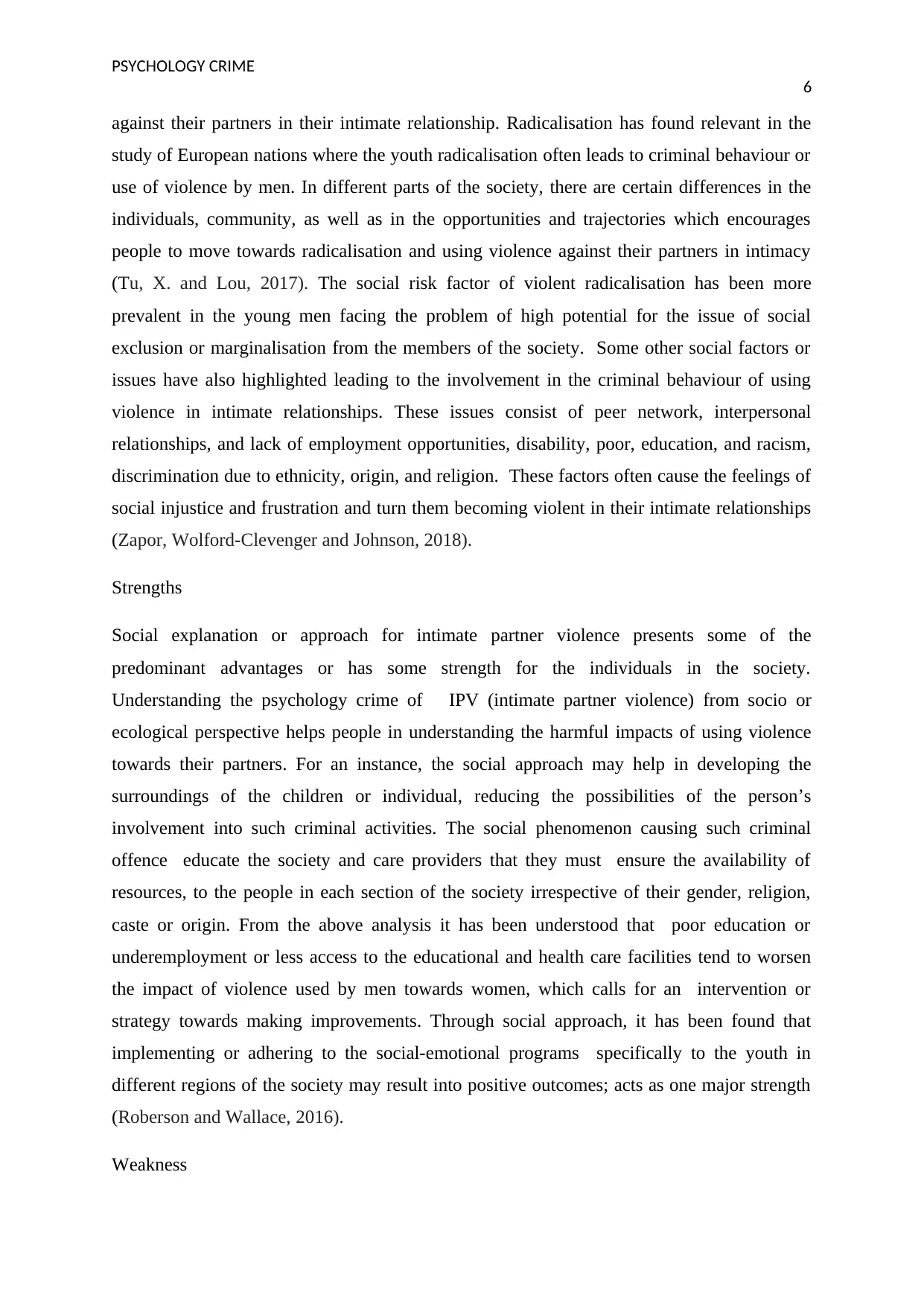
PSYCHOLOGY CRIME
6
against their partners in their intimate relationship. Radicalisation has found relevant in the
study of European nations where the youth radicalisation often leads to criminal behaviour or
use of violence by men. In different parts of the society, there are certain differences in the
individuals, community, as well as in the opportunities and trajectories which encourages
people to move towards radicalisation and using violence against their partners in intimacy
(Tu, X. and Lou, 2017). The social risk factor of violent radicalisation has been more
prevalent in the young men facing the problem of high potential for the issue of social
exclusion or marginalisation from the members of the society. Some other social factors or
issues have also highlighted leading to the involvement in the criminal behaviour of using
violence in intimate relationships. These issues consist of peer network, interpersonal
relationships, and lack of employment opportunities, disability, poor, education, and racism,
discrimination due to ethnicity, origin, and religion. These factors often cause the feelings of
social injustice and frustration and turn them becoming violent in their intimate relationships
(Zapor, Wolford-Clevenger and Johnson, 2018).
Strengths
Social explanation or approach for intimate partner violence presents some of the
predominant advantages or has some strength for the individuals in the society.
Understanding the psychology crime of IPV (intimate partner violence) from socio or
ecological perspective helps people in understanding the harmful impacts of using violence
towards their partners. For an instance, the social approach may help in developing the
surroundings of the children or individual, reducing the possibilities of the person’s
involvement into such criminal activities. The social phenomenon causing such criminal
offence educate the society and care providers that they must ensure the availability of
resources, to the people in each section of the society irrespective of their gender, religion,
caste or origin. From the above analysis it has been understood that poor education or
underemployment or less access to the educational and health care facilities tend to worsen
the impact of violence used by men towards women, which calls for an intervention or
strategy towards making improvements. Through social approach, it has been found that
implementing or adhering to the social-emotional programs specifically to the youth in
different regions of the society may result into positive outcomes; acts as one major strength
(Roberson and Wallace, 2016).
Weakness
6
against their partners in their intimate relationship. Radicalisation has found relevant in the
study of European nations where the youth radicalisation often leads to criminal behaviour or
use of violence by men. In different parts of the society, there are certain differences in the
individuals, community, as well as in the opportunities and trajectories which encourages
people to move towards radicalisation and using violence against their partners in intimacy
(Tu, X. and Lou, 2017). The social risk factor of violent radicalisation has been more
prevalent in the young men facing the problem of high potential for the issue of social
exclusion or marginalisation from the members of the society. Some other social factors or
issues have also highlighted leading to the involvement in the criminal behaviour of using
violence in intimate relationships. These issues consist of peer network, interpersonal
relationships, and lack of employment opportunities, disability, poor, education, and racism,
discrimination due to ethnicity, origin, and religion. These factors often cause the feelings of
social injustice and frustration and turn them becoming violent in their intimate relationships
(Zapor, Wolford-Clevenger and Johnson, 2018).
Strengths
Social explanation or approach for intimate partner violence presents some of the
predominant advantages or has some strength for the individuals in the society.
Understanding the psychology crime of IPV (intimate partner violence) from socio or
ecological perspective helps people in understanding the harmful impacts of using violence
towards their partners. For an instance, the social approach may help in developing the
surroundings of the children or individual, reducing the possibilities of the person’s
involvement into such criminal activities. The social phenomenon causing such criminal
offence educate the society and care providers that they must ensure the availability of
resources, to the people in each section of the society irrespective of their gender, religion,
caste or origin. From the above analysis it has been understood that poor education or
underemployment or less access to the educational and health care facilities tend to worsen
the impact of violence used by men towards women, which calls for an intervention or
strategy towards making improvements. Through social approach, it has been found that
implementing or adhering to the social-emotional programs specifically to the youth in
different regions of the society may result into positive outcomes; acts as one major strength
(Roberson and Wallace, 2016).
Weakness
Paraphrase This Document
Need a fresh take? Get an instant paraphrase of this document with our AI Paraphraser

PSYCHOLOGY CRIME
7
Although social explanation for the crime of partner or domestic violence has stated some
strength to every individual identified in the crime or the people at risk from violence from
their partners, however there are some weaknesses of social approach. Several studies have
conducted but they did not result into favourable outcomes, because the changes are not
implemented on a larger level. Another weakness of studying the crime from a social
perspective includes extremism and anti-social behaviour of the administrations and
management in the shelter homes, where they are supposed to promote positive change.
Despite the relative importance of the growing concern of IPV as a major public health issue,
there has been a predominant lack of proper initiatives or evidences in consideration to the
appropriate health system response. A recent review of the interventions taken to improve
the situation of women suffering from the issue of IPV has represented an improvement in
health-related quality of life, reducing the risk factors. This has been the reason, which may
reduce IPV, and enhance the safety promoting behaviours of individuals towards their
partners, but the still lack in eradicating the violence in appropriate manner (Marquant and
Nedopil, 2018).
To contrast between these two explanations of biological and social psychological
perspective for intimate partner violence, it has understood that both the approaches tend to
define different factors of an individual. Biological and social risk factors are different from
each other and affect the health-related quality of life of women or an individual in different
manner. Discussing and comparing the two, it has been analysed that social explanation is
more effective and appropriate to understand the importance and relevance towards the crime
of partner violence by men against their partners. Therefore, social explanation for IPV has
gained wider acceptance and popularity amongst the two explanation for IPV (Gashaw, Schei
and Magnus, 2018).
From the contrast made on the above explanations, it has observed that the biological and
social explanations on IPV have great utility in the society, and on the quality of life. These
explanations or aspects can be useful in preventing crime, and leading women sustain a
healthy and quality life. The biological explanation for IPV will help to understand the
impact of the change due to prison/post-prison behaviour. As the men from the treatment
received in prisons experience a negative and unhealthy life, which leads them, become
violent and exercise violence towards their partners at homes. Partners for prevention (P4P),
7
Although social explanation for the crime of partner or domestic violence has stated some
strength to every individual identified in the crime or the people at risk from violence from
their partners, however there are some weaknesses of social approach. Several studies have
conducted but they did not result into favourable outcomes, because the changes are not
implemented on a larger level. Another weakness of studying the crime from a social
perspective includes extremism and anti-social behaviour of the administrations and
management in the shelter homes, where they are supposed to promote positive change.
Despite the relative importance of the growing concern of IPV as a major public health issue,
there has been a predominant lack of proper initiatives or evidences in consideration to the
appropriate health system response. A recent review of the interventions taken to improve
the situation of women suffering from the issue of IPV has represented an improvement in
health-related quality of life, reducing the risk factors. This has been the reason, which may
reduce IPV, and enhance the safety promoting behaviours of individuals towards their
partners, but the still lack in eradicating the violence in appropriate manner (Marquant and
Nedopil, 2018).
To contrast between these two explanations of biological and social psychological
perspective for intimate partner violence, it has understood that both the approaches tend to
define different factors of an individual. Biological and social risk factors are different from
each other and affect the health-related quality of life of women or an individual in different
manner. Discussing and comparing the two, it has been analysed that social explanation is
more effective and appropriate to understand the importance and relevance towards the crime
of partner violence by men against their partners. Therefore, social explanation for IPV has
gained wider acceptance and popularity amongst the two explanation for IPV (Gashaw, Schei
and Magnus, 2018).
From the contrast made on the above explanations, it has observed that the biological and
social explanations on IPV have great utility in the society, and on the quality of life. These
explanations or aspects can be useful in preventing crime, and leading women sustain a
healthy and quality life. The biological explanation for IPV will help to understand the
impact of the change due to prison/post-prison behaviour. As the men from the treatment
received in prisons experience a negative and unhealthy life, which leads them, become
violent and exercise violence towards their partners at homes. Partners for prevention (P4P),

PSYCHOLOGY CRIME
8
is a step undertaken by the UN provides knowledge and technical support and ensure
prevention of gender-based violence. UN has become responsible through enacting
educational programmes, for men, and boys to change their behaviour and attitude towards
their partners and become less violent (Sardinha and Catalan, 2018).
Therefore, these explanations have their major use and applicability in the formulation of
policies towards preventing IPV on women.
To state about the reliability of the explanation towards creating the laws or rules, using these
explanations, such as General Law on Women’s access to a life-free of violence. The law
explains the psychological behaviour and favour development of women through equality
and non-discrimination.
Laws such as Violence against Women Reauthorization act 2013 has been also formulated
which defines about the applicability, reliability, or validity of the violence. Health Services
Research and Development has been a major contributor, in defining and establishing
prevention methods for IPV, CDC (centre for disease control and prevention) has been a
major research body which consistently supports these explanation and the occurrence or
prevention of the violence against women. The current scenario explaining the significance of
IPV from biological and social perspectives is approachable from every individual in the 21st
century. Thus, in order to improve prevention strategies, to prevent occurrence of crime
against women there has been a constant and supportive role of these explanations in the
society.
Intimate partner violence (IPV) has been a major public health concern in the modern society
amongst different age groups. The major implications observed on the policy makers, as need
to ensure the practice and implementation of the appropriate strategies in the healthcare as
well as communities to support and reduce IPV. The need of the research into identifying and
implementing necessary aspects of policies requires evaluating current health sector and
systems and identifying the barriers. Implications of IPV has been considered crucial for
both, survivors and the society, as there is a predominant contribution of the social workers
in addressing IPV to a major extent. Social workers are responsible towards IPV in terms of
undertaking legislation, policies, practice, and advocacy and this social justice brief serves as
an affirmation, ensuring commitment to work with the advocates and other health
8
is a step undertaken by the UN provides knowledge and technical support and ensure
prevention of gender-based violence. UN has become responsible through enacting
educational programmes, for men, and boys to change their behaviour and attitude towards
their partners and become less violent (Sardinha and Catalan, 2018).
Therefore, these explanations have their major use and applicability in the formulation of
policies towards preventing IPV on women.
To state about the reliability of the explanation towards creating the laws or rules, using these
explanations, such as General Law on Women’s access to a life-free of violence. The law
explains the psychological behaviour and favour development of women through equality
and non-discrimination.
Laws such as Violence against Women Reauthorization act 2013 has been also formulated
which defines about the applicability, reliability, or validity of the violence. Health Services
Research and Development has been a major contributor, in defining and establishing
prevention methods for IPV, CDC (centre for disease control and prevention) has been a
major research body which consistently supports these explanation and the occurrence or
prevention of the violence against women. The current scenario explaining the significance of
IPV from biological and social perspectives is approachable from every individual in the 21st
century. Thus, in order to improve prevention strategies, to prevent occurrence of crime
against women there has been a constant and supportive role of these explanations in the
society.
Intimate partner violence (IPV) has been a major public health concern in the modern society
amongst different age groups. The major implications observed on the policy makers, as need
to ensure the practice and implementation of the appropriate strategies in the healthcare as
well as communities to support and reduce IPV. The need of the research into identifying and
implementing necessary aspects of policies requires evaluating current health sector and
systems and identifying the barriers. Implications of IPV has been considered crucial for
both, survivors and the society, as there is a predominant contribution of the social workers
in addressing IPV to a major extent. Social workers are responsible towards IPV in terms of
undertaking legislation, policies, practice, and advocacy and this social justice brief serves as
an affirmation, ensuring commitment to work with the advocates and other health
⊘ This is a preview!⊘
Do you want full access?
Subscribe today to unlock all pages.

Trusted by 1+ million students worldwide
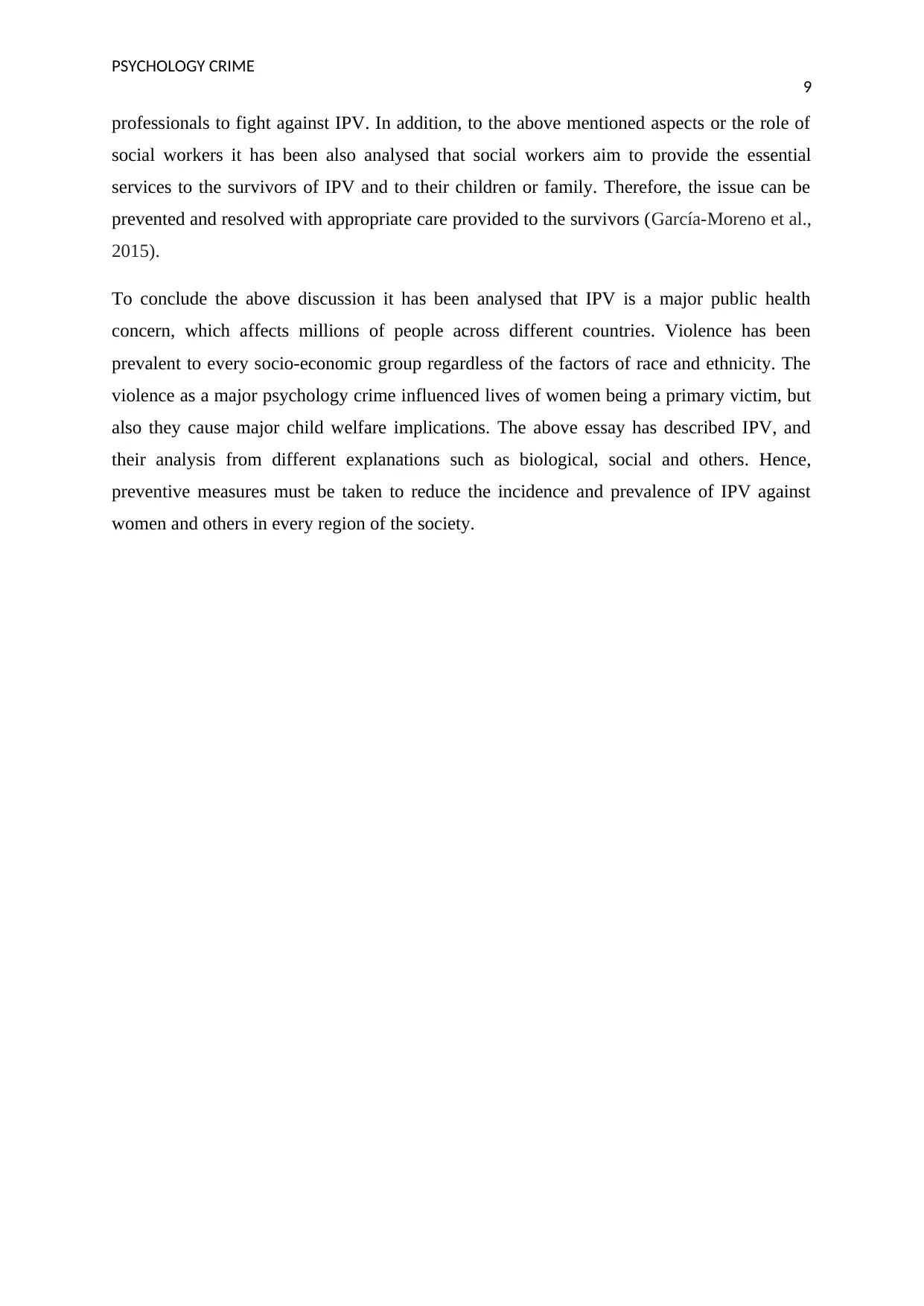
PSYCHOLOGY CRIME
9
professionals to fight against IPV. In addition, to the above mentioned aspects or the role of
social workers it has been also analysed that social workers aim to provide the essential
services to the survivors of IPV and to their children or family. Therefore, the issue can be
prevented and resolved with appropriate care provided to the survivors (García-Moreno et al.,
2015).
To conclude the above discussion it has been analysed that IPV is a major public health
concern, which affects millions of people across different countries. Violence has been
prevalent to every socio-economic group regardless of the factors of race and ethnicity. The
violence as a major psychology crime influenced lives of women being a primary victim, but
also they cause major child welfare implications. The above essay has described IPV, and
their analysis from different explanations such as biological, social and others. Hence,
preventive measures must be taken to reduce the incidence and prevalence of IPV against
women and others in every region of the society.
9
professionals to fight against IPV. In addition, to the above mentioned aspects or the role of
social workers it has been also analysed that social workers aim to provide the essential
services to the survivors of IPV and to their children or family. Therefore, the issue can be
prevented and resolved with appropriate care provided to the survivors (García-Moreno et al.,
2015).
To conclude the above discussion it has been analysed that IPV is a major public health
concern, which affects millions of people across different countries. Violence has been
prevalent to every socio-economic group regardless of the factors of race and ethnicity. The
violence as a major psychology crime influenced lives of women being a primary victim, but
also they cause major child welfare implications. The above essay has described IPV, and
their analysis from different explanations such as biological, social and others. Hence,
preventive measures must be taken to reduce the incidence and prevalence of IPV against
women and others in every region of the society.
Paraphrase This Document
Need a fresh take? Get an instant paraphrase of this document with our AI Paraphraser
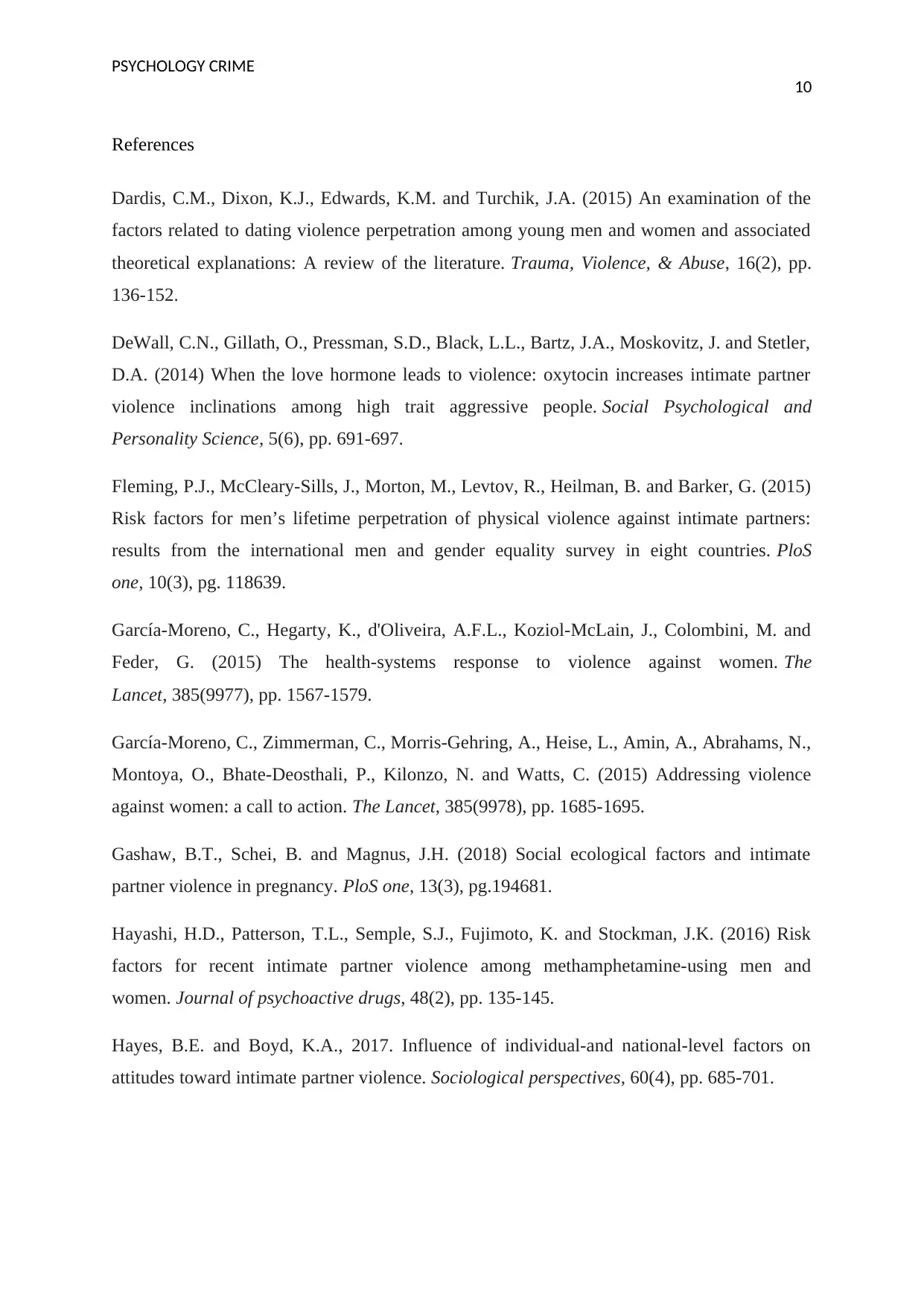
PSYCHOLOGY CRIME
10
References
Dardis, C.M., Dixon, K.J., Edwards, K.M. and Turchik, J.A. (2015) An examination of the
factors related to dating violence perpetration among young men and women and associated
theoretical explanations: A review of the literature. Trauma, Violence, & Abuse, 16(2), pp.
136-152.
DeWall, C.N., Gillath, O., Pressman, S.D., Black, L.L., Bartz, J.A., Moskovitz, J. and Stetler,
D.A. (2014) When the love hormone leads to violence: oxytocin increases intimate partner
violence inclinations among high trait aggressive people. Social Psychological and
Personality Science, 5(6), pp. 691-697.
Fleming, P.J., McCleary-Sills, J., Morton, M., Levtov, R., Heilman, B. and Barker, G. (2015)
Risk factors for men’s lifetime perpetration of physical violence against intimate partners:
results from the international men and gender equality survey in eight countries. PloS
one, 10(3), pg. 118639.
García-Moreno, C., Hegarty, K., d'Oliveira, A.F.L., Koziol-McLain, J., Colombini, M. and
Feder, G. (2015) The health-systems response to violence against women. The
Lancet, 385(9977), pp. 1567-1579.
García-Moreno, C., Zimmerman, C., Morris-Gehring, A., Heise, L., Amin, A., Abrahams, N.,
Montoya, O., Bhate-Deosthali, P., Kilonzo, N. and Watts, C. (2015) Addressing violence
against women: a call to action. The Lancet, 385(9978), pp. 1685-1695.
Gashaw, B.T., Schei, B. and Magnus, J.H. (2018) Social ecological factors and intimate
partner violence in pregnancy. PloS one, 13(3), pg.194681.
Hayashi, H.D., Patterson, T.L., Semple, S.J., Fujimoto, K. and Stockman, J.K. (2016) Risk
factors for recent intimate partner violence among methamphetamine-using men and
women. Journal of psychoactive drugs, 48(2), pp. 135-145.
Hayes, B.E. and Boyd, K.A., 2017. Influence of individual-and national-level factors on
attitudes toward intimate partner violence. Sociological perspectives, 60(4), pp. 685-701.
10
References
Dardis, C.M., Dixon, K.J., Edwards, K.M. and Turchik, J.A. (2015) An examination of the
factors related to dating violence perpetration among young men and women and associated
theoretical explanations: A review of the literature. Trauma, Violence, & Abuse, 16(2), pp.
136-152.
DeWall, C.N., Gillath, O., Pressman, S.D., Black, L.L., Bartz, J.A., Moskovitz, J. and Stetler,
D.A. (2014) When the love hormone leads to violence: oxytocin increases intimate partner
violence inclinations among high trait aggressive people. Social Psychological and
Personality Science, 5(6), pp. 691-697.
Fleming, P.J., McCleary-Sills, J., Morton, M., Levtov, R., Heilman, B. and Barker, G. (2015)
Risk factors for men’s lifetime perpetration of physical violence against intimate partners:
results from the international men and gender equality survey in eight countries. PloS
one, 10(3), pg. 118639.
García-Moreno, C., Hegarty, K., d'Oliveira, A.F.L., Koziol-McLain, J., Colombini, M. and
Feder, G. (2015) The health-systems response to violence against women. The
Lancet, 385(9977), pp. 1567-1579.
García-Moreno, C., Zimmerman, C., Morris-Gehring, A., Heise, L., Amin, A., Abrahams, N.,
Montoya, O., Bhate-Deosthali, P., Kilonzo, N. and Watts, C. (2015) Addressing violence
against women: a call to action. The Lancet, 385(9978), pp. 1685-1695.
Gashaw, B.T., Schei, B. and Magnus, J.H. (2018) Social ecological factors and intimate
partner violence in pregnancy. PloS one, 13(3), pg.194681.
Hayashi, H.D., Patterson, T.L., Semple, S.J., Fujimoto, K. and Stockman, J.K. (2016) Risk
factors for recent intimate partner violence among methamphetamine-using men and
women. Journal of psychoactive drugs, 48(2), pp. 135-145.
Hayes, B.E. and Boyd, K.A., 2017. Influence of individual-and national-level factors on
attitudes toward intimate partner violence. Sociological perspectives, 60(4), pp. 685-701.
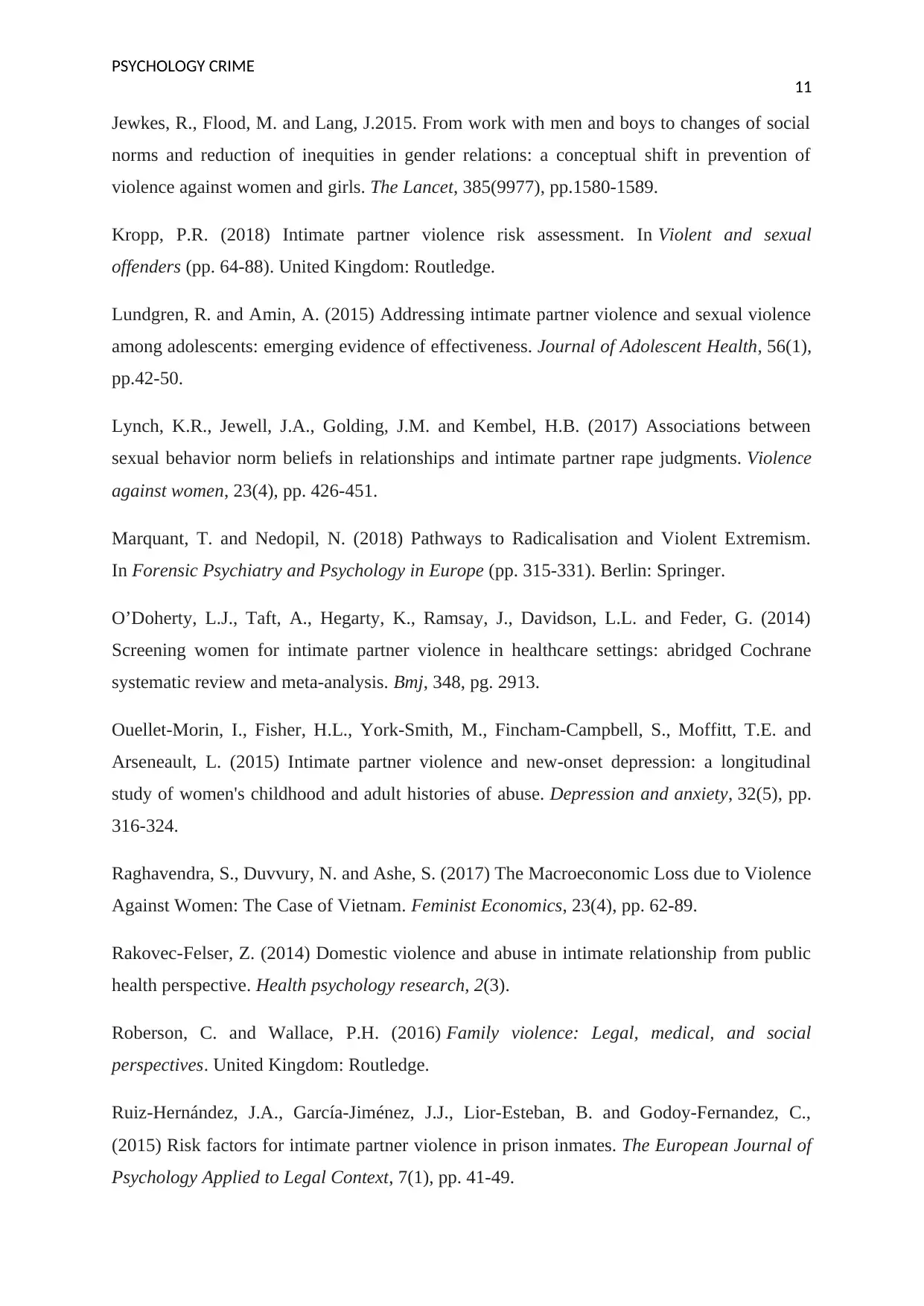
PSYCHOLOGY CRIME
11
Jewkes, R., Flood, M. and Lang, J.2015. From work with men and boys to changes of social
norms and reduction of inequities in gender relations: a conceptual shift in prevention of
violence against women and girls. The Lancet, 385(9977), pp.1580-1589.
Kropp, P.R. (2018) Intimate partner violence risk assessment. In Violent and sexual
offenders (pp. 64-88). United Kingdom: Routledge.
Lundgren, R. and Amin, A. (2015) Addressing intimate partner violence and sexual violence
among adolescents: emerging evidence of effectiveness. Journal of Adolescent Health, 56(1),
pp.42-50.
Lynch, K.R., Jewell, J.A., Golding, J.M. and Kembel, H.B. (2017) Associations between
sexual behavior norm beliefs in relationships and intimate partner rape judgments. Violence
against women, 23(4), pp. 426-451.
Marquant, T. and Nedopil, N. (2018) Pathways to Radicalisation and Violent Extremism.
In Forensic Psychiatry and Psychology in Europe (pp. 315-331). Berlin: Springer.
O’Doherty, L.J., Taft, A., Hegarty, K., Ramsay, J., Davidson, L.L. and Feder, G. (2014)
Screening women for intimate partner violence in healthcare settings: abridged Cochrane
systematic review and meta-analysis. Bmj, 348, pg. 2913.
Ouellet‐Morin, I., Fisher, H.L., York‐Smith, M., Fincham‐Campbell, S., Moffitt, T.E. and
Arseneault, L. (2015) Intimate partner violence and new‐onset depression: a longitudinal
study of women's childhood and adult histories of abuse. Depression and anxiety, 32(5), pp.
316-324.
Raghavendra, S., Duvvury, N. and Ashe, S. (2017) The Macroeconomic Loss due to Violence
Against Women: The Case of Vietnam. Feminist Economics, 23(4), pp. 62-89.
Rakovec-Felser, Z. (2014) Domestic violence and abuse in intimate relationship from public
health perspective. Health psychology research, 2(3).
Roberson, C. and Wallace, P.H. (2016) Family violence: Legal, medical, and social
perspectives. United Kingdom: Routledge.
Ruiz-Hernández, J.A., García-Jiménez, J.J., Lior-Esteban, B. and Godoy-Fernandez, C.,
(2015) Risk factors for intimate partner violence in prison inmates. The European Journal of
Psychology Applied to Legal Context, 7(1), pp. 41-49.
11
Jewkes, R., Flood, M. and Lang, J.2015. From work with men and boys to changes of social
norms and reduction of inequities in gender relations: a conceptual shift in prevention of
violence against women and girls. The Lancet, 385(9977), pp.1580-1589.
Kropp, P.R. (2018) Intimate partner violence risk assessment. In Violent and sexual
offenders (pp. 64-88). United Kingdom: Routledge.
Lundgren, R. and Amin, A. (2015) Addressing intimate partner violence and sexual violence
among adolescents: emerging evidence of effectiveness. Journal of Adolescent Health, 56(1),
pp.42-50.
Lynch, K.R., Jewell, J.A., Golding, J.M. and Kembel, H.B. (2017) Associations between
sexual behavior norm beliefs in relationships and intimate partner rape judgments. Violence
against women, 23(4), pp. 426-451.
Marquant, T. and Nedopil, N. (2018) Pathways to Radicalisation and Violent Extremism.
In Forensic Psychiatry and Psychology in Europe (pp. 315-331). Berlin: Springer.
O’Doherty, L.J., Taft, A., Hegarty, K., Ramsay, J., Davidson, L.L. and Feder, G. (2014)
Screening women for intimate partner violence in healthcare settings: abridged Cochrane
systematic review and meta-analysis. Bmj, 348, pg. 2913.
Ouellet‐Morin, I., Fisher, H.L., York‐Smith, M., Fincham‐Campbell, S., Moffitt, T.E. and
Arseneault, L. (2015) Intimate partner violence and new‐onset depression: a longitudinal
study of women's childhood and adult histories of abuse. Depression and anxiety, 32(5), pp.
316-324.
Raghavendra, S., Duvvury, N. and Ashe, S. (2017) The Macroeconomic Loss due to Violence
Against Women: The Case of Vietnam. Feminist Economics, 23(4), pp. 62-89.
Rakovec-Felser, Z. (2014) Domestic violence and abuse in intimate relationship from public
health perspective. Health psychology research, 2(3).
Roberson, C. and Wallace, P.H. (2016) Family violence: Legal, medical, and social
perspectives. United Kingdom: Routledge.
Ruiz-Hernández, J.A., García-Jiménez, J.J., Lior-Esteban, B. and Godoy-Fernandez, C.,
(2015) Risk factors for intimate partner violence in prison inmates. The European Journal of
Psychology Applied to Legal Context, 7(1), pp. 41-49.
⊘ This is a preview!⊘
Do you want full access?
Subscribe today to unlock all pages.

Trusted by 1+ million students worldwide
1 out of 13
Related Documents
Your All-in-One AI-Powered Toolkit for Academic Success.
+13062052269
info@desklib.com
Available 24*7 on WhatsApp / Email
![[object Object]](/_next/static/media/star-bottom.7253800d.svg)
Unlock your academic potential
Copyright © 2020–2025 A2Z Services. All Rights Reserved. Developed and managed by ZUCOL.





